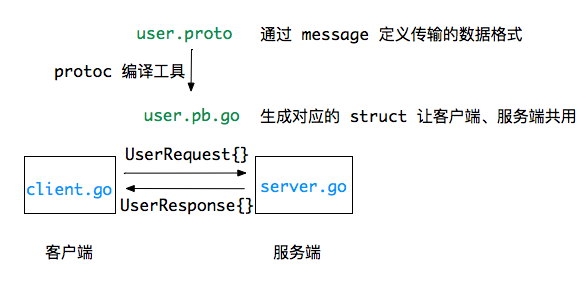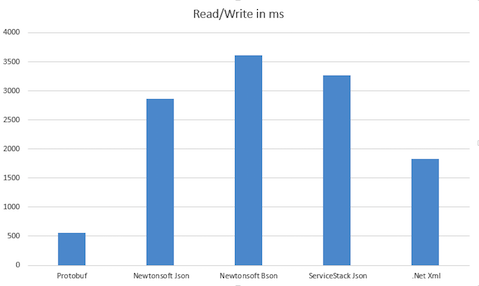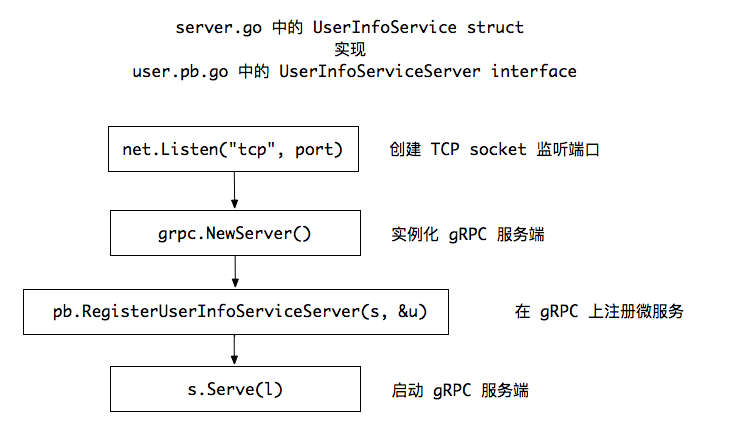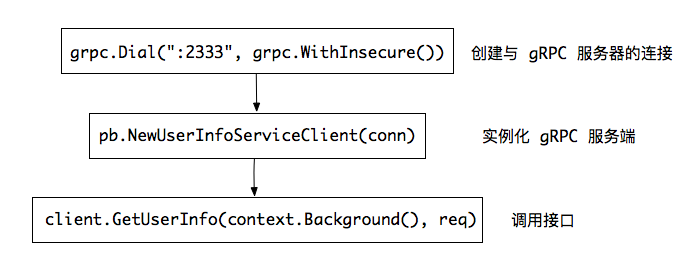gRPC 使用 protobuf 构建微服务
微服务架构
单一的代码库
以前使用 Laravel 做 Web 项目时,是根据 MVC 去划分目录结构的,即 Controller 层处理业务逻辑,Model 层处理数据库的 CURD,View 层处理数据渲染与页面交互。以及 MVP、MVVM 都是将整个项目的代码是集中在一个代码库中,进行业务处理。这种单一聚合代码的方式在前期实现业务的速度很快,但在后期会暴露很多问题:
- 开发与维护困难:随着业务复杂度的增加,代码的耦合度往往会变高,多个模块相互耦合后不易横向扩展
- 效率和可靠性低:过大的代码量将降低响应速度,应用潜在的安全问题也会累积
拆分的代码库
微服务是一种软件架构,它将一个大且聚合的业务项目拆解为多个小且独立的业务模块,模块即服务,各服务间使用高效的协议(protobuf、JSON 等)相互调用即是 RPC。这种拆分代码库的方式有以下特点:
- 每个服务应作为小规模的、独立的业务模块在运行,类似 Unix 的 Do one thing and do it well
- 每个服务应在进行自动化测试和(分布式)部署时,不影响其他服务
每个服务内部进行细致的错误检查和处理,提高了健壮性
二者对比
本质上,二者只是聚合与拆分代码的方式不同。

参考: 微服务架构的优势与不足
构建微服务
UserInfoService 微服务
接下来创建一个处理用户信息的微服务:UserInfoService,客户端通过 name 向服务端查询用户的年龄、职位等详细信息,需先安装 gRPC 与 protoc 编译器:
go get -u google.golang.org/grpc go get -u github.com/golang/protobuf/protoc-gen-go
目录结构
├── proto │ ├── user.proto // 定义客户端请求、服务端响应的数据格式 │ └── user.pb.go // protoc 为 gRPC 生成的读写数据的函数 ├── server.go // 实现微服务的服务端 └── client.go // 调用微服务的客户端
调用流程

Protobuf 协议
每个微服务有自己独立的代码库,各自之间在通信时需要高效的协议,要遵循一定的数据结构来解析和编码要传输的数据,在微服务中常使用 protobuf 来定义。
Protobuf(protocal buffers)是谷歌推出的一种二进制数据编码格式,相比 XML 和 JSON 的文本数据编码格式更有优势:
- 读写更快、文件体积更小
- 它没有 XML 的标签名或 JSON 的字段名,更为轻量, 更多参考 。

语言中立
只需定义一份 .proto 文件,即可使用各语言对应的 protobuf 编译器对其编译,生成的文件中有对 message 编码、解码的函数。
对于 JSON
- 在 PHP 中需使用 json_encode() 和 json_decode() 去编解码,在 Golang 中需使用 json 标准库的 Marshal() 和 Unmarshal() … 每次解析和编码比较繁琐
- 优点:可读性好、开发成本低
- 缺点:相比 protobuf 的读写速度更慢、存储空间更多
对于 Protobuf
- .proto 可生成 .php 或 *.pb.go … 在项目中可直接引用该文件中编译器生成的编码、解码函数
- 优点:高效轻量、一处定义多处使用
- 缺点:可读性差、开发成本高
定义微服务的 user.proto 文件
syntax = "proto3"; // 指定语法格式,注意 proto3 不再支持 proto2 的 required 和 optional
package proto; // 指定生成的 user.pb.go 的包名,防止命名冲突
// service 定义开放调用的服务,即 UserInfoService 微服务
service UserInfoService {
// rpc 定义服务内的 GetUserInfo 远程调用
rpc GetUserInfo (UserRequest) returns (UserResponse) {
}
}
// message 对应生成代码的 struct
// 定义客户端请求的数据格式
message UserRequest {
// [修饰符] 类型 字段名 = 标识符;
string name = 1;
}
// 定义服务端响应的数据格式
message UserResponse {
int32 id = 1;
string name = 2;
int32 age = 3;
repeated string title = 4; // repeated 修饰符表示字段是可变数组,即 slice 类型
}
编译 user.proto 文件
# protoc 编译器的 grpc 插件会处理 service 字段定义的 UserInfoService # 使 service 能编码、解码 message $ protoc -I . --go_out=plugins=grpc:. ./user.proto
生成 user.pb.go
package proto
import (
context "golang.org/x/net/context"
grpc "google.golang.org/grpc"
)
// 请求结构
type UserRequest struct {
Name string `protobuf:"bytes,1,opt,name=name" json:"name,omitempty"`
}
// 为字段自动生成的 Getter
func (m *UserRequest) GetName() string {
if m != nil {
return m.Name
}
return ""
}
// 响应结构
type UserResponse struct {
Id int32 `protobuf:"varint,1,opt,name=id" json:"id,omitempty"`
Name string `protobuf:"bytes,2,opt,name=name" json:"name,omitempty"`
Age int32 `protobuf:"varint,3,opt,name=age" json:"age,omitempty"`
Title []string `protobuf:"bytes,4,rep,name=title" json:"title,omitempty"`
}
// ...
// 客户端需实现的接口
type UserInfoServiceClient interface {
GetUserInfo(ctx context.Context, in *UserRequest, opts ...grpc.CallOption) (*UserResponse, error)
}
// 服务端需实现的接口
type UserInfoServiceServer interface {
GetUserInfo(context.Context, *UserRequest) (*UserResponse, error)
}
// 将微服务注册到 grpc
func RegisterUserInfoServiceServer(s *grpc.Server, srv UserInfoServiceServer) {
s.RegisterService(&_UserInfoService_serviceDesc, srv)
}
// 处理请求
func _UserInfoService_GetUserInfo_Handler(srv interface{}, ctx context.Context, dec func(interface{}) error, interceptor grpc.UnaryServerInterceptor) (interface{}, error) {...}
服务端实现微服务
实现流程

代码参考
package main
import (...)
// 定义服务端实现约定的接口
type UserInfoService struct{}
var u = UserInfoService{}
// 实现 interface
func (s *UserInfoService) GetUserInfo(ctx context.Context, req *pb.UserRequest) (resp *pb.UserResponse, err error) {
name := req.Name
// 模拟在数据库中查找用户信息
// ...
if name == "wuYin" {
resp = &pb.UserResponse{
Id: 233,
Name: name,
Age: 20,
Title: []string{"Gopher", "PHPer"}, // repeated 字段是 slice 类型
}
}
err = nil
return
}
func main() {
port := ":2333"
l, err := net.Listen("tcp", port)
if err != nil {
log.Fatalf("listen error: %v/n", err)
}
fmt.Printf("listen %s/n", port)
s := grpc.NewServer()
// 将 UserInfoService 注册到 gRPC
// 注意第二个参数 UserInfoServiceServer 是接口类型的变量
// 需要取地址传参
pb.RegisterUserInfoServiceServer(s, &u)
s.Serve(l)
}
运行监听:

客户端调用
实现流程

代码参考
package main
import (...)
func main() {
conn, err := grpc.Dial(":2333", grpc.WithInsecure())
if err != nil {
log.Fatalf("dial error: %v/n", err)
}
defer conn.Close()
// 实例化 UserInfoService 微服务的客户端
client := pb.NewUserInfoServiceClient(conn)
// 调用服务
req := new(pb.UserRequest)
req.Name = "wuYin"
resp, err := client.GetUserInfo(context.Background(), req)
if err != nil {
log.Fatalf("resp error: %v/n", err)
}
fmt.Printf("Recevied: %v/n", resp)
}
运行调用成功:

总结
在上边 UserInfoService 微服务的实现过程中,会发现每个微服务都需要自己管理服务端监听端口,客户端连接后调用,当有很多个微服务时端口的管理会比较麻烦,相比 gRPC,go-micro 实现了服务发现(Service Discovery)来方便的管理微服务,下节将随服务的 Docker 化一起学习。 如果你想和更多微服务技术专家交流,可以加我微信liyingjiese,备注『加群』。群里每周都有全球各大公司的最佳实践以及行业最新动态 。
原文链接: https://wuyin.io/2018/05/02/pr ... lang/











![[HBLOG]公众号](https://www.liuhaihua.cn/img/qrcode_gzh.jpg)

